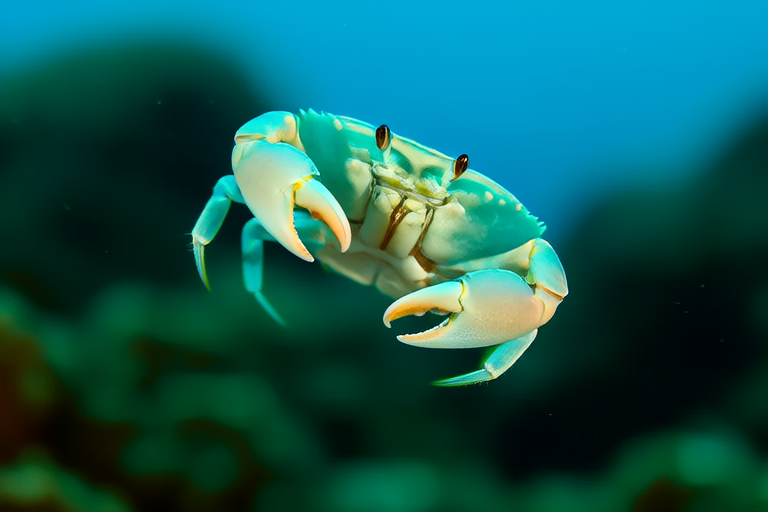From Ocean Depths to Your Aquarium: Discovering the Enigmatic Pea Crab
The world of marine life is vast and varied, teeming with creatures that have adapted to some of the harshest conditions on Earth. Among the lesser-known inhabitants of the deep blue are the pea crabs, a group of tiny crustaceans that have captivated scientists and aquarium enthusiasts alike. This article delves into the fascinating world of pea crabs, exploring their unique characteristics, symbiotic relationships, lifecycle, and the challenges of keeping them in home aquariums.
Unique Characteristics and Habitat
Pea crabs, belonging to the family Pinnotheridae, are named for their diminutive size, typically ranging from 3 to 8 millimeters in length. Their petite stature belies their importance in marine ecosystems. These crabs are found in diverse marine habitats around the world, from shallow coastal waters to the depths of the ocean. They are particularly abundant in estuaries and coral reefs, where they find ample food and shelter.
Despite their small size, pea crabs are incredibly resilient, capable of thriving in environments with fluctuating salinity levels, temperatures, and pressures. Their ability to adapt to such varied conditions is a testament to their evolutionary success. Pea crabs are often found in association with other marine organisms, forming intricate and beneficial relationships that highlight the interconnectedness of marine life.
Symbiotic Relationships
One of the most remarkable aspects of pea crabs is their symbiotic relationship with other sea creatures. These tiny crustaceans are obligate commensals, meaning they rely on their hosts for protection and food. The most common hosts for pea crabs are sea cucumbers and barnacles.
In their relationship with sea cucumbers, pea crabs reside within the body cavity of their host. Here, they benefit from the protection provided by the sea cucumber’s tough skin and the constant flow of water through its respiratory system. In return, pea crabs consume detritus and small particles of food that the sea cucumber cannot digest, essentially cleaning out its digestive tract. This mutualistic relationship ensures the health of both parties, as the sea cucumber benefits from improved digestion and the pea crab from a steady supply of nutrients.
With barnacles, pea crabs live within the calcified plates of the barnacle, offering protection from predators and harsh environmental conditions. While the barnacle provides shelter, the pea crab scavenges for food, feeding on plankton and detritus that enters the barnacle’s feeding apparatus. This relationship underscores the complexity and interdependence of marine ecosystems.
Lifecycle and Diet
The lifecycle of pea crabs is characterized by significant changes as they transition from larvae to adults. Female pea crabs lay eggs in the protective environment of their host, where the larvae hatch and develop. Once mature, the adult crabs leave the host to find a new one, repeating the cycle. This lifecycle is critical for the survival of the species, ensuring genetic diversity and the continuation of symbiotic relationships.
The diet of pea crabs is primarily composed of detritus, plankton, and other small organic particles. They are adept at scavenging and can consume a wide variety of food sources, which contributes to their adaptability and survival in different marine environments. Their role as scavengers helps maintain the cleanliness of their host’s living space, further enhancing the symbiotic relationship.
Adaptation to Marine Pressures and Temperatures
Pea crabs have evolved to withstand the extreme pressures and temperatures of the ocean. They possess a hard exoskeleton that protects them from physical damage and helps regulate their internal environment. Additionally, their small size allows them to occupy narrow spaces within their hosts, providing an additional layer of protection from external threats.
The ability of pea crabs to thrive under varying conditions makes them valuable indicators of the health of marine ecosystems. Changes in their distribution or abundance can signal shifts in environmental conditions, providing crucial data for marine biologists and conservationists.
Challenges and Considerations for Home Aquariums
For those interested in bringing a piece of the ocean into their homes, keeping pea crabs in aquariums presents both opportunities and challenges. One of the primary considerations is ensuring the appropriate tank conditions. Pea crabs require clean, well-oxygenated water with stable salinity and temperature levels. A reef tank setup is ideal, as it mimics their natural habitat and provides a suitable environment for their hosts.
Selecting compatible tank mates is equally important. Pea crabs should be housed with species that are not predatory and do not pose a threat to their small size. Sea cucumbers and certain types of sponges make excellent companions, as they provide the necessary protection and food source. It is essential to avoid aggressive fish or invertebrates that might prey on the pea crabs.
Maintaining a balanced ecosystem in the aquarium is key to the well-being of pea crabs. Regular water changes, proper filtration, and monitoring of water parameters are necessary to ensure a healthy environment. Additionally, providing ample hiding spots and ensuring the presence of their preferred hosts will enhance their comfort and longevity in captivity.
The Importance of Studying Pea Crabs
The study of pea crabs offers valuable insights into marine biology and conservation efforts. Understanding their symbiotic relationships and adaptations can inform strategies for protecting vulnerable marine ecosystems. As climate change and human activities continue to impact the oceans, the role of pea crabs as indicators of environmental health becomes increasingly important.
Moreover, research into pea crabs can contribute to advancements in aquaculture and sustainable practices. By studying their interactions with hosts, scientists can develop methods to improve the health and productivity of farmed marine organisms, ultimately benefiting both the environment and industry.
As we continue to explore the mysteries of the ocean, the enigmatic pea crab stands as a reminder of the complexity and beauty of marine life. Their unique characteristics, symbiotic relationships, and adaptability offer a window into the wonders of the deep, inspiring both scientific inquiry and appreciation for the natural world.
